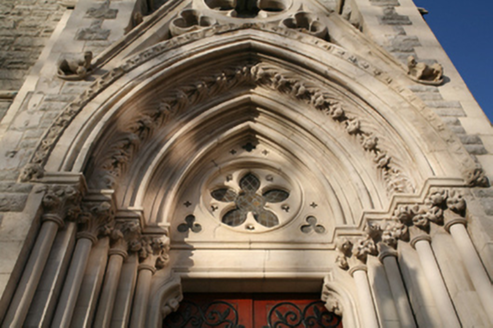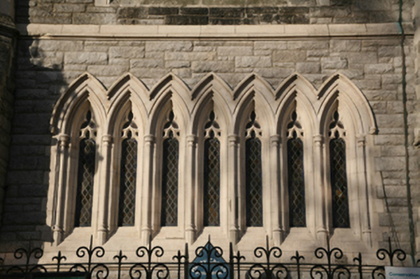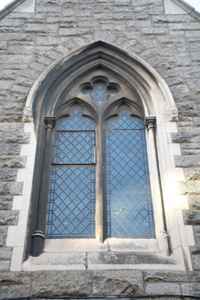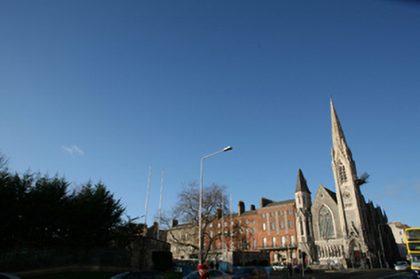Survey Data
Reg No
50010910
Rating
Regional
Categories of Special Interest
Architectural, Artistic, Historical, Scientific, Social, Technical
Original Use
Church/chapel
In Use As
Church/chapel
Date
1860 - 1865
Coordinates
315652, 235185
Date Recorded
17/12/2011
Date Updated
--/--/--
Description
Attached corner-sited freestanding gable-fronted stone-built Gothic Revival Presbyterian church, built 1862-4, to designs of Andrew Heiton. Rectangular plan facing south with three-stage corner entrance tower and spire to east, lower three-stage stair tower to west and triple gabled east nave elevation. Attached gable-fronted two-storey school building abutting north rear elevation. Steeply pitched slate roof with fish-scale slate courses and triangular lucarnes with trefoil timber openings. Replacement metal rainwater goods breaking through to either side of gables with Portland stone crocketed coping to gables. Random coursed squared rock-faced granite ashlar walls with Portland stone dressings to projecting plinth course and gabled buttresses with arcaded spire finials. Three-stage tower on square plan with octagonal stone spire having quatrefoil and trefoil openings, decorative pierced courses and surmounted by copper ball finial. The upper bell-stage to tower has gabled finials rising from angle buttresses flanking pointed-arch openings with paired trefoil-headed louvred openings surmounted by pierced and crocketed gables. Middle clock-stage has metal round clock face to each elevation with continuous string course rising to form crocketed surround. Below clock is diminutive arcaded light with colonettes and splayed sill resting on continuous string course. Principal pointed arched entrance to lower stage with deeply inset shouldered square-headed door opening flanked by series of colonettes with stiff-leaf capitals and compound moulded pointed arch having stone over-panel pierced with cinquefoil light. Doorcase surmounted by crocketed gable with trefoil and quatrefoil panels flanked by gableted buttresses. Double-leaf diagonally-sheeted timber doors with iron door furniture open onto flight of stone steps to gated front platform. Front gable has large pointed-arch window with Portland stone geometric tracery window having stained leaded glazing, splayed sill, hood-moulding and lozenge opening to gable. Arcaded seven light opening to ground floor level below having colonettes, splayed sill and continuous hood-moulding with leaded coloured glazing. Shouldered paired window openings to plinth course lighting basement. Three-stage stair tower projecting beyond gable to west, canted to front and rear, forming irregular octagonal plan. Steeply pitched slate roof with spouts to eaves and copper ridge. Series of pointed arched openings to upper stage with continuous hood-moulding and leaded glazing. Middle stage comprises series of pointed-arch window openings with gable over each fronting battered base to upper stage. Secondary trefoil-headed entrance to lower stage with low gabled surround and tall blind gables to either side, having polished timber sheeted door flanked by columns and stiff-leaf capitals to compound moulded arch. Door opens onto four stone steps to front railed area. Triple gabled east nave each having large pointed-arch window with five-light geometric tracery and stained leaded glazing surmounted by a quatrefoil opening to each gable. Paired shouldered basement window openings to the plinth course with steel-framed glazing. Rear north gable has large rose window. Buttress to northeast corner extends northwards to house further pointed-arch entrance with quatrefoil over-panel and segmental-headed door opening with double-leaf timber doors and front railed area enclosing school building. Gable-fronted school building has single pointed-arch window opening to upper level with bipartite trefoil-headed lights and central buttress to ground floor dividing two triple arched window openings with trefoil heads, colonettes and latticed leaded glazing. Decorative wrought-iron railings on low plinth wall span buttress to buttress on east nave elevation while enclosing front area to south front with two pairs of matching iron gates, those to principal entrance hung on pair of Portland stone piers surmounted by gabled arcaded finials supporting wrought-iron lanterns.
Appraisal
This church is an example of flamboyant Decorated Gothic religious architecture, designed by Andrew Heiton and funded by Alexander Findlater in 1864, hence the alternate name for the building, Findlater's Church. Occupying a highly prominent site on the elevated north side of Parnell Square this decorative church has only two visible facades but manages to fill them with a wealth of Gothic detailing and devices. The spire and tower have been recently restored and are highly visible from O’Connell Street and the northern and eastern approaches. More closely related to French Gothic churches than English churches the landmark structure is the only representative of its style on this Georgian square and now forms part of Dublin’s skyline and its historic Georgian core.

































